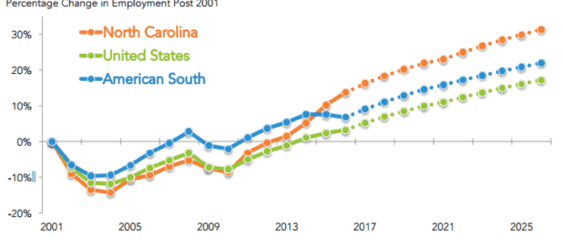Making News
David Brooks’ New York Times column this week cited an essay by Nicholas Eberstadt, “Our Miserable 21st Century.” Despite the depressing title, the piece is chocked full with data and frames about the first 20% of the new century. It’s worth the read. Here are a couple of highlights:
- “Between 2000 and 2016, per capita growth in America has averaged less than 1 percent a year. To state it plainly: With postwar, pre-21st-century rates for the years 2000–2016, per capita GDP in America would be more than 20 percent higher than it is today.”
- As of late 2016, the adult work rate in America was still at its lowest level in more than 30 years. To put things another way: If our nation’s work rate today were back up to its start-of-the-century highs, well over 10 million more Americans would currently have paying jobs.
- According to the Census Bureau’s SIPP survey (Survey of Income and Program Participation), as of 2013, over one-fifth (21 percent) of all civilian men between 25 and 55 years of age were Medicaid beneficiaries. For prime-age people not in the labor force, the share was over half (53 percent). And for un-working Anglos (non-Hispanic white men not in the labor force) of prime working age, the share enrolled in Medicaid was 48 percent.
Dropping Knowledge
Duke University professor Nicholas Carnes and his UNC-CH colleague Eric Hansen have published a study demonstrating that legislative pay does not lead to greater working class participation in the legislature. Specifically, their research suggests that states with the highest legislative salaries actually have slightly lower rates of participation among working class citizens. The research is well-covered by the News and Observer and the Pacific Standard, but a conversation with Professor Carnes provided some additional context to the research.
“If you’re backing a bill that would raise the salary for the General Assembly, I would say a lot of the research is on your side. If your intuition is that higher pay would allow for members to better focus on the job of legislating, to be more likely to make it to every single roll call vote, to more fully invest their effort and energy into the job of serving the state, then your instinct is squarely in line with what the research says,” Carnes explained.
“The one caveat is that you should recognize that when you’re raising the pay, you are counterintuitively not making it easier for lower income people to hold office.”
In the Weeds
North Carolina is 29th in financial positioning, according to accounting firm PWC, which recently released its State Financial Positions Index and competitiveness posture report. “The rankings are based on financial information contained in the audited financial statements for each state for Fiscal 2015 as summarized by the Institute for Truth in Accounting, and a composite ranking of each state’s competitive posture in 2016 based on independent assessments by CEO Magazine, CNBC and Forbes.”
“Most of the states with better relative financial positions also rank highly in competitiveness and are net inbound states. Conversely, most of the states with a poor relative financial positions rank low in competitiveness and are net outbound states.”
I hesitate to give much credence to this sort of report without better understanding the methodology. That said, it is interesting to see how the state compares to our peers via this index: Tennessee is 9th, Virginia is 13th, Georgia is 24th, and South Carolina is 33rd.


